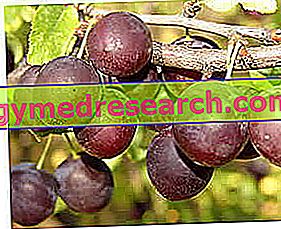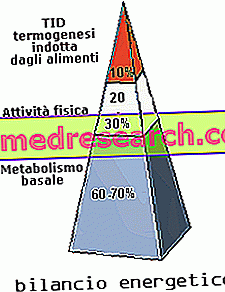What are
Classification
The plums are the fruit (drupe) of the plum tree; in reality, plums and plum are also the respective synonyms of plums and plum, the latter botanically known as Prunus domestica (Rosaceae Family, Subfamily Prunoideae).

Description
the plums (subsp. insititia ) are smaller and tapering compared to other plums; when fully ripe, they have a blue-violet epicarp characterized by the massive presence of bloom (a protective wax towards microorganisms) while the mesocarp (pulp) is clear, yellowish, translucent and enveloping the woody endocarp (hazel) containing the almond. The flavor of the plum ( insititia or dasmon ) is more sour and intense than that of other plums, which is why the fruit is more suitable for storage in cans. The pulp of the plum insititia or dasmon does not separate well from the core.
Among all the plums, there are Sottospecies and roundish varieties, with black epicarp (very dark violet), purplish and yellow; among those with black or purplish epicarp, some fruits have an equally dark pulp, while the yellow ones always have a yellowish pulp.
Plum Venom
NB : Not everyone knows that the almond of the plum (and plums in general) owes its bitter taste to amygdalin, a toxic cyano-genetic substance typically found in bitter almonds. Due to the latter, it is not recommended to make frequent and / or significant use of plum almonds.
Distribution and cultivation ( Prunus domestica, all subspecies and varieties)
The plums / plums are now widespread in America, Asia and throughout Europe, and therefore also in Italy. In the Bel Paese, the production of plums / plums is around 20, 000 tons per year; however, national consumption appears to be progressively reduced. The regions of greatest development are Emilia-Romagna (35%), Campania (23%), Piedmont (6.9%), Lazio (5.8%), Marche (4.5%) and Basilicata (4.4% ). The most cultivated varieties of plums / plums are essentially of oriental origin (mainly widespread in the south, available from June to October), while the European ones cover a marginal share and are limited to some Emilian plots.
Recipes and nutritional properties
Plums can be eaten fresh (recommended) or preserved; among the latter, we recall those: dried or dehydrated (natural or with sulphites, the first rich in antioxidant melanoidins, the second additives), in syrup, in jam, in spirit, candied, etc. It is also necessary to specify that there are various alcoholic beverages on the market, both traditional and last generation, based on plums (or flavored with them).
Plums are foods that belong to the VI and VII group of foods, even if the relative content in vit. C (ascorbic acid) and retinol equivalent (vit. A) is not among the highest.
Plums contain a lot of water and fiber, a useful feature for all those who suffer from constipation. NB: the laxative action mechanism of plums is the same as for products that increase the fecal volume.
The plums also play an important antioxidant function, not so much for the sole content in vit. C and carotenoids (which as we have seen is not among the most important in the category), as for their association with phenolic substances.
Plums are also rich in mineral salts; among these, the most relevant is undoubtedly potassium.
The energy supply is of medium size, or a compromise between winter and summer fruit; energy molecules are mainly composed of simple carbohydrates (fructose), while lipids and proteins are not worthy of note.
Nutritional values
Nutritional composition for 100 grams of edible portion of fresh, dried, yellow and red plums - Reference Values of Food Composition Tables - INRAN.
| Plums, fresh | Dried plums | Yellow plums | Red plums | ||
| Edible part | 90.0% | 88.0% | 96.0% | 87.0% | |
| water | 87.5g | 29.3g | 87.7g | 87.5g | |
| Protein | 0.5g | 2.2g | 0.5g | 0.5g | |
| Prevailing amino acids | - | - | - | - | |
| Limiting amino acid | - | - | - | - | |
| Lipids TOT | 0.1g | 0.5g | 0.1g | 0.1g | |
| Saturated fatty acids | - g | - g | - g | - g | |
| Monounsaturated fatty acids | - g | - g | - g | - g | |
| Polyunsaturated fatty acids | - g | - g | - g | - g | |
| Cholesterol | 0.0mg | 0.0mg | 0.0mg | 0.0mg | |
| TOT Carbohydrates | 10.5g | 55, 0g | 7.2g | 10.50g | |
| Complex sugars | 0.0g | 0.0g | 0.0g | 0.0g | |
| Soluble sugars | 10.5g | 55, 0g | 7.2g | 10.50g | |
| Dietary fiber | 1.5g | 8.4g | 1.4g | 1.6g | |
| Soluble fiber | 0.60g | 3.60g | 0.53g | 0.67g | |
| Insoluble fiber | 0.87g | 4.84g | 0.84g | 0.91g | |
| Power | 42.0kcal | 220.0kcal | 30.0kcal | 42.0kcal | |
| Sodium | 2.0mg | 8.0mg | 2.0mg | - mg | |
| Potassium | 190.0mg | 824.0mg | 202.0mg | - mg | |
| Iron | 0.2mg | 3.9mg | 0.3mg | - mg | |
| Football | 13.0mg | 59.0mg | 4.0mg | - mg | |
| Phosphorus | 14.0mg | 85.0mg | 18.0mg | - mg | |
| Thiamine | 0.08mg | 0.18mg | - mg | - mg | |
| Riboflavin | 0.05mg | 0.02mg | - mg | - mg | |
| Niacin | 0.50mg | 1.00mg | - mg | - mg | |
| Vitamin A | 16.0μg | 19.0μg | - mg | - mg | |
| C vitamin | 5.0mg | 3.0mg | - mg | - mg | |
| Vitamin E | - mg | - mg | - mg | - mg | |
Reference websites
- English Wikipedia: Damson - //en.wikipedia.org/wiki/Damson
- Agriculture of the Campania region: Susino - //www.agricoltura.regione.campania.it/frutticoltura/liste_varietali_susino.pdf



